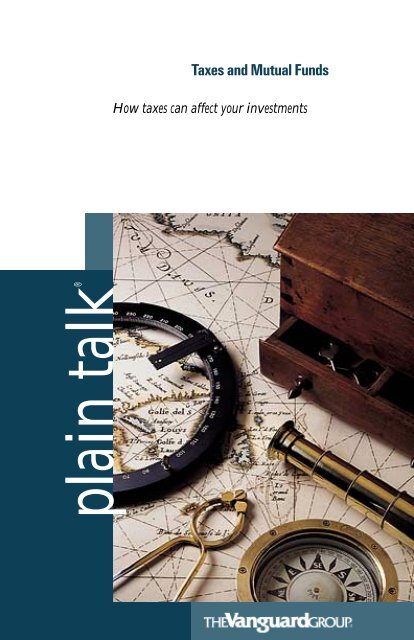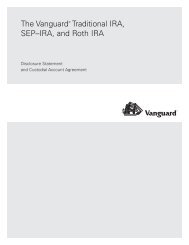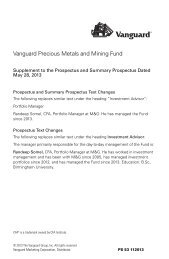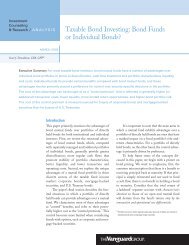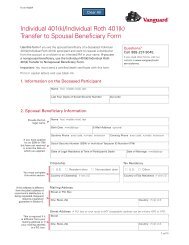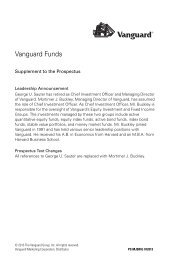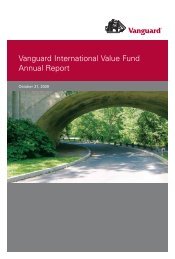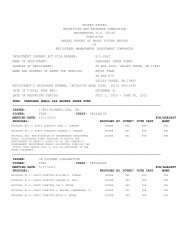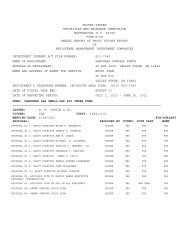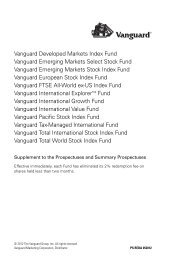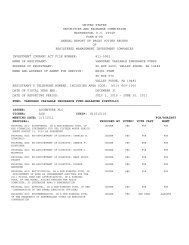You also want an ePaper? Increase the reach of your titles
YUMPU automatically turns print PDFs into web optimized ePapers that Google loves.
plain talk®<br />
<strong>Taxes</strong> <strong>and</strong> <strong>Mutual</strong> <strong>Funds</strong><br />
How taxes can affect your investments
Why Plain Talk?<br />
At The Vanguard Group—a leading proponent of investor education in<br />
the mutual fund industry—we believe that knowledge is one of the<br />
keys to investment success. To that end, we have developed our Plain<br />
Talk Library, a series of c<strong>and</strong>id, concise, <strong>and</strong> easy-to-underst<strong>and</strong><br />
publications on a wide variety of investment topics.<br />
To request a free copy of any of these brochures, call us at<br />
1-800-662-7447 on business days from 8 a.m. to 10 p.m. <strong>and</strong><br />
on Saturdays from 9 a.m. to 4 p.m., Eastern time. You can also<br />
read or order them online at www.vanguard.com.<br />
We hope you find the information in the Plain Talk Library helpful as<br />
you chart your investment course with us.<br />
■ <strong>Mutual</strong> Fund Basics<br />
■ The Vanguard Investment Planner<br />
■ Women <strong>and</strong> Investing<br />
■ Financing College<br />
■ Preparing to Retire<br />
■ Investing During Retirement<br />
■ Estate Planning Basics<br />
■ How to Select a Financial Adviser<br />
■ Measuring <strong>Mutual</strong> Fund Performance<br />
■ Bear Markets<br />
■ Bond Fund Investing<br />
■ Index Investing<br />
■ International Investing<br />
■ <strong>Taxes</strong> <strong>and</strong> <strong>Mutual</strong> <strong>Funds</strong><br />
■ Dollar-Cost Averaging<br />
■ Why Vanguard?
<strong>Taxes</strong> <strong>and</strong> <strong>Mutual</strong> <strong>Funds</strong><br />
<strong>Taxes</strong> are an important consideration for investors. Unless<br />
you pay careful attention to the tax implications of your<br />
mutual fund investments, taxes can sharply reduce the<br />
earnings you are actually able to keep. Fortunately, you don’t<br />
need an accounting or law degree to underst<strong>and</strong> the basics of<br />
taxes <strong>and</strong> mutual funds.<br />
This Plain Talk brochure explains how mutual fund investments<br />
are taxed. The focus is on mutual funds in taxable accounts, but<br />
we will also note how you can delay or even completely avoid<br />
taxes by using tax-deferred or tax-exempt accounts.<br />
Though this brochure is not meant to serve as a complete guide<br />
for all tax questions, it can help you make sound investment<br />
decisions, choose funds that are appropriate for you, <strong>and</strong><br />
minimize the impact of taxes on your investment returns.<br />
Note that a glossary appears at the back of this brochure. Terms<br />
that may be new to readers are printed in blue (for example, cost<br />
basis) the first time they occur.
Contents<br />
How Your <strong>Mutual</strong> Fund Investments Are Taxed ....................................... 1<br />
How a Fund’s Investment Strategy Can Affect <strong>Taxes</strong> ............................... 8<br />
Calculating <strong>and</strong> Reporting Your <strong>Taxes</strong> ...................................................... 12<br />
The Impact of <strong>Taxes</strong> on Your Investment Returns .................................... 17<br />
What to Do About <strong>Taxes</strong> ........................................................................... 19<br />
Tax-Efficient Vanguard <strong>Funds</strong> ................................................................... 24<br />
Vanguard’s Tax Information Services ........................................................ 26<br />
A Vanguard Invitation ............................................................................... 28<br />
Glossary .................................................................................................... 30
H OW YOUR M UTUAL F UND<br />
I NVESTMENTS A RE TAXED<br />
Since your goal as an investor should be to keep as much as<br />
possible of what you earn from mutual fund investments, you<br />
can’t look past the inescapable reality that taxes take a big bite<br />
out of bottom-line returns.<br />
As a mutual fund investor, you can incur income taxes in three<br />
ways: when the fund distributes income dividends, when the<br />
fund distributes capital gains from the sale of securities, <strong>and</strong><br />
when you sell or exchange fund shares at a profit. First we’ll<br />
explain how a fund’s earnings are taxed—then we’ll show how<br />
your sales or exchanges of shares can trigger taxes.<br />
Owning shares <strong>and</strong> paying taxes<br />
A mutual fund is not taxed on the income or profits it earns<br />
on its investments as long as it passes those earnings along<br />
to shareholders. The shareholders, in turn, pay any taxes due.<br />
Two common types of distributions that mutual funds make<br />
are income distributions <strong>and</strong> capital gains distributions.<br />
■ Income distributions represent all interest <strong>and</strong> dividend income<br />
earned by securities—whether cash investments, bonds, or<br />
stocks—after the fund’s operating expenses are subtracted.<br />
■ Capital gains distributions represent the profit a fund makes<br />
when it sells securities. When a fund makes such a profit, a<br />
capital gain is realized. When a fund sells securities at a price<br />
lower than it paid, it realizes a capital loss. If total capital gains<br />
exceed total capital losses, the fund has net realized capital gains,<br />
which are distributed to fund shareholders. Net realized capital<br />
losses are not passed through to shareholders but are retained<br />
by the fund <strong>and</strong> may be used to offset future capital gains.<br />
1
Occasionally distributions from mutual funds may include a<br />
return of capital. Returns of capital are not taxed (unless they<br />
exceed your original cost basis) because they are considered<br />
a portion of your original investment being returned to you.<br />
Generally, income dividend <strong>and</strong> capital gains distributions are<br />
subject to federal income taxes (<strong>and</strong> often state <strong>and</strong> local taxes as<br />
well). You must pay taxes on distributions regardless of whether<br />
you receive them in cash or reinvest them in additional shares.<br />
The exceptions to the general rule are:<br />
■ U.S. Treasury securities, whose interest income is exempt from<br />
state income taxes.<br />
■ Municipal bond funds, whose interest income is exempt from<br />
federal income tax <strong>and</strong> may be exempt from state taxes as well.<br />
However, any capital gains on U.S. Treasury securities or<br />
municipal bond funds are generally taxable.<br />
While the amount of income <strong>and</strong> capital gains you receive from a<br />
mutual fund affects the taxes you pay, another important factor is<br />
the holding period—that is, how long the fund held the securities<br />
before they were sold. Securities held for one year or less before<br />
being sold are categorized as short-term capital gains (or losses).<br />
Short-term capital gains are taxed at your ordinary income tax<br />
rate, as shown in Figure 1. But long-term capital gains—gains on<br />
Figure 1<br />
Federal Income Tax Rates<br />
Rates applied to taxable income in 2001<br />
15% 28% 31% 36% 39.6%<br />
Single Up to $ 27,051 to $ 65,551 to $136,751 to $297,351<br />
$27,050 $ 65,550 $136,750 $297,350 <strong>and</strong> up<br />
Married, Up to $ 45,201 to $109,251 to $166,501 to $297,351<br />
Filing Jointly $45,200 $109,250 $166,500 $297,350 <strong>and</strong> up<br />
Married, Up to $ 22,601 to $ 54,626 to $ 83,251 to $148,676<br />
Filing Separately $22,600 $ 54,625 $ 83,250 $148,675 <strong>and</strong> up<br />
Note: Income brackets are adjusted annually for inflation.<br />
Source: Internal Revenue Service.<br />
2
New tax rates on certain capital gains<br />
Federal income tax rates have been reduced on certain capital gains known<br />
as “qualified five-year gains.”<br />
■ For taxpayers in the 15% bracket, the tax rate on capital gains from the<br />
sale of assets that have been held longer than five years has dropped<br />
from 10% to 8%. Tax rates on capital gains from the sale of assets held<br />
five years or less are unchanged.<br />
■ For taxpayers in the higher brackets (28%, 31%, 36%, <strong>and</strong> 39.6%), the tax<br />
rate on capital gains from the sale of assets purchased after January 1,<br />
2001, <strong>and</strong> held longer than five years (that is, the assets are not sold until<br />
2006 or later) has dropped from 20% to 18%. Tax rates on capital gains<br />
from the sale of assets held five years or less are unchanged.<br />
Taxpayers in the higher brackets (28% or higher) can make assets they own<br />
eligible for the 18% rate (rather than the 20% rate) in 2006 or later by treating<br />
those assets as having been sold <strong>and</strong> reacquired at their closing prices on<br />
January 2, 2001. By “marking assets to market” in this way, a taxpayer can<br />
recognize capital gains (but not losses). The gains as of January 2 are taxed<br />
currently at the old rate of 20% (or a higher rate if it’s a short-term gain) <strong>and</strong><br />
must be reported to the IRS in a letter filed with the investor’s tax return for the<br />
tax year that includes January 1, 2001. If the asset is then sold in 2006 or later,<br />
increases in the value of that asset are taxed at the 18% rate.<br />
Example: An investor bought 100 shares of a company for $1,000, or $10<br />
a share, in 1996. On January 2, 2001, the shares closed at $20 each. The<br />
investor marks them to market <strong>and</strong> pays a 20% tax on her $1,000 profit—a<br />
total of $200 in tax. In 2006, she sells the shares for $3,000, or $30 a share,<br />
so she has a five-year gain of another $1,000 that is taxable at 18% ($180).<br />
Her total tax bill is $380—$200 paid in 2001 <strong>and</strong> $180 paid in 2006. If she<br />
had not marked the shares to market, her total tax bill would have been $400<br />
in 2006—so she saved $20. However, the $200 paid in taxes in 2001 could<br />
have been invested from 2001 to 2006, possibly earning more than $20.<br />
We recommend that you consult a tax or financial adviser about whether<br />
marking to market would be beneficial in your individual situation. Be sure<br />
to consider state <strong>and</strong> local income taxes in making your decision.<br />
3
securities the fund held for longer than one year before being sold—<br />
are taxed at a maximum rate of 20%. (The long-term capital gains<br />
rate is a maximum rate of 10% for taxpayers in the lowest income<br />
tax bracket.)<br />
Your mutual fund will tell you the category of any capital gains<br />
it distributes. This is determined by how long the fund held the<br />
securities it sold, not by how long you have owned your shares.<br />
For example, say you first bought shares in a fund last month <strong>and</strong><br />
today the fund is making a capital gains distribution as a result<br />
of selling securities it owned for five years. That distribution is<br />
a long-term capital gain because the fund’s holding period was<br />
longer than one year. On the other h<strong>and</strong>, say you bought shares<br />
in a mutual fund ten years ago. The fund makes a capital gains<br />
distribution because it sold securities it had held for six months.<br />
That distribution is a short-term capital gain for you because<br />
the fund’s holding period was less than one year.<br />
These are key distinctions simply because not all investment income<br />
is treated equally. Income (such as interest <strong>and</strong> dividends) <strong>and</strong> shortterm<br />
capital gains are taxed as ordinary income at your marginal tax<br />
rate (which can range from 15% to 39.6%, as shown in Figure 1 on<br />
page 2). Net capital gains on securities held longer than one year<br />
are taxed at a maximum rate of 20% (a maximum rate of 10% for<br />
taxpayers in the lowest tax bracket).<br />
Internal Revenue Service Form 1099-DIV, which your mutual<br />
fund usually sends in January for the previous tax year, details fund<br />
distributions you must report on your federal income tax return,<br />
including both income distributions <strong>and</strong> capital gains distributions<br />
from your funds. You won’t receive a Form 1099-DIV for mutual<br />
funds that distribute tax-exempt interest dividends (such as<br />
municipal bond funds) or for funds on which you earned less<br />
than $10 in dividends. (However, you still owe taxes on all taxable<br />
distributions, regardless of their size.) For more information,<br />
see Calculating <strong>and</strong> Reporting Your <strong>Taxes</strong> on page 12.<br />
4
<strong>Taxes</strong> on sales or exchanges of shares<br />
You can trigger capital gains taxes on mutual fund investments by<br />
selling some or all of your shares at a profit, or by exchanging shares<br />
of one fund for shares of another. The length of time you hold<br />
shares <strong>and</strong> your tax bracket determine the tax rate on any gain.<br />
Three important notes:<br />
■ All capital gains from your sale of mutual fund shares are<br />
taxable, even those from the sale of shares of a tax-exempt fund.<br />
■ Exchanging shares between funds is considered a sale, which<br />
may lead to capital gains. (An exchange involves selling shares of<br />
one fund to buy shares in another.)<br />
■ Writing a check against an investment in a mutual fund<br />
with a fluctuating share price (all funds except money market<br />
funds) also triggers a sale of shares <strong>and</strong> may expose you to<br />
tax on any resulting capital gains.<br />
Timing affects your taxes<br />
Here’s an example of how timing may affect taxes on the sale of mutual fund<br />
shares: If you buy 100 shares of mutual fund ABC for $20 a share <strong>and</strong> sell<br />
them six months later for $22 a share, you owe taxes on your $200 shortterm<br />
capital gain. If you’re in the 31% marginal tax bracket, that’s $62.<br />
However, if you hold on to the shares for more than 12 months after the<br />
original purchase, your profit is considered a long-term gain. Therefore, it is<br />
taxed at a maximum capital gains rate of 20% (for a maximum total tax of<br />
$40 on the $200 capital gain).<br />
Real-life calculations often aren’t so tidy, especially for investors who buy<br />
mutual fund shares at different times <strong>and</strong> at different prices. In Calculating<br />
<strong>and</strong> Reporting Your <strong>Taxes</strong> (pages 12–16), we’ll explain how to figure gains or<br />
losses on sales of mutual fund shares.<br />
5
Don’t buy a tax bill with your fund shares<br />
The tax owed on mutual fund investments may also depend in part<br />
on when you buy the shares. <strong>Mutual</strong> fund distributions, whether<br />
from income dividends or capital gains, are taxed in the year they<br />
are made. However, under certain circumstances, distributions<br />
declared during the last three months of a year <strong>and</strong> paid the<br />
following January are taxable in the year they were declared.<br />
If you hold shares in mutual funds that declare dividends daily<br />
—such as money market <strong>and</strong> bond funds—you are entitled to<br />
a dividend for each day you own shares in the fund. For other<br />
funds, such as stock <strong>and</strong> balanced funds, dividend <strong>and</strong> capital<br />
gains distributions are not declared daily but according to a<br />
regular schedule (monthly, quarterly, semiannually, or annually).<br />
When a mutual fund makes a distribution, its share price (or net<br />
asset value) falls by the amount of the distribution. For example,<br />
let’s say you own 1,000 shares of Fund X worth $10,000, or<br />
$10 a share. The fund distributes $1 a share in capital gains, so<br />
its share price drops to $9 a share on the fund’s reinvestment<br />
date (not counting market activity). You’ll still have $10,000<br />
(1,000 x $9 = $9,000, plus the $1,000 distribution). But you’ll<br />
owe tax on the $1,000 distribution, even if you reinvest it to buy<br />
more shares.<br />
So when considering a purchase of fund shares, ask the fund<br />
company about the fund’s next distribution—when it will take<br />
place <strong>and</strong> how large it is expected to be. If you own shares on<br />
the fund’s record date, you will receive the distribution. That<br />
means if you purchase shares shortly before the record date,<br />
you are “buying the distribution”—you’ll owe taxes on the<br />
capital gains that were reflected in the share price when you<br />
bought shares. In effect, a portion of your investment is being<br />
“returned” to you as a taxable capital gain.<br />
6
Tax-deferred <strong>and</strong> tax-exempt accounts<br />
The rules explained in this brochure apply only to taxable investments, not<br />
to tax-deferred investments such as those in employer-sponsored retirement<br />
plans (401(k) <strong>and</strong> 403(b) plans), individual retirement accounts (traditional<br />
IRAs), or variable annuities. Nor do these rules apply to Roth IRAs, which<br />
can be tax-free at withdrawal.<br />
Usually people are not taxed on the earnings in tax-deferred accounts<br />
until they start withdrawing money from the accounts—typically during<br />
retirement. Whether the withdrawals take the form of a lump sum or an<br />
installment payment, the taxable portion is always considered ordinary<br />
income (as opposed to capital gains) <strong>and</strong> thus taxed at the taxpayer’s<br />
marginal rate for the years when the withdrawals occur. IRA withdrawals<br />
taken before age 591 /2 are generally taxable <strong>and</strong> subject to an additional<br />
10% penalty tax. (Note, however, that distributions from Roth IRAs after a<br />
taxpayer reaches age 591 /2 will be tax-free if the Roth IRA has been held<br />
longer than five years.)<br />
Some tax-deferred investments offer added tax advantages. For example,<br />
you may be able to contribute wages or salary on a pre-tax basis. In a 401(k)<br />
plan, for example, money you contribute to the plan is deducted from your<br />
pay before it is taxed, which reduces your taxable wages. Similarly, many<br />
investors can deduct some or all of their contributions to traditional IRAs,<br />
which also reduces their taxable income. (Contributions to Roth IRAs are<br />
never deductible.)<br />
In retirement plans that allow pre-tax contributions (for example, 401(k)<br />
plans <strong>and</strong> traditional IRAs), withdrawals from the account are taxed as<br />
ordinary income. But for after-tax contributions to tax-deferred accounts<br />
(for example, if you invest $1,000 of take-home pay in a variable annuity<br />
or a nondeductible traditional IRA), you pay taxes only on earnings that<br />
accumulate in the account, because the contribution has already been taxed.<br />
7
H OW A F UND’ S I NVESTMENT S TRATEGY<br />
CAN A FFECT TAXES<br />
The likelihood that a mutual fund will pass along taxable<br />
distributions is heavily influenced by two factors: the kinds of<br />
securities the fund invests in <strong>and</strong> the fund’s investment policies.<br />
Security holdings<br />
Money market funds<br />
Most money market funds pay dividends that are fully taxable.<br />
(Some funds—those that invest in municipal securities—earn<br />
interest that is generally not subject to federal income tax <strong>and</strong><br />
that often is exempt from state <strong>and</strong> local taxes as well.*) However,<br />
because these funds are designed to maintain a constant value<br />
of $1 per share,** they do not ordinarily generate capital gains or<br />
losses, either within the fund or as the result of sales or exchanges<br />
you make.<br />
Bond funds<br />
Ordinarily, bond funds produce relatively high levels of taxable<br />
income. Over long periods, almost all the return from bond funds<br />
comes from dividend payments. However, because the prices of<br />
bonds <strong>and</strong> bond funds fluctuate in response to changing interest<br />
rates, it is possible to have taxable capital gains from investing in<br />
bond funds, even tax-exempt bond funds. Sometimes a fund will<br />
generate taxable capital gains distributions by selling bonds at<br />
a profit. Alternatively, a shareholder can trigger a capital gain<br />
by selling shares in a bond fund for a price higher than the<br />
original cost.<br />
8<br />
*For some investors, however, a portion of the fund’s income may be subject to the<br />
alternative minimum tax.<br />
**An investment in a money market fund is not insured or guaranteed by the<br />
Federal Deposit Insurance Corporation or any other government agency.<br />
Although a money market fund seeks to preserve the value of your investment<br />
at $1 per share, it is possible to lose money by investing in such a fund.
Stock funds<br />
Stock funds may pass along income from dividends paid by<br />
stocks held in the fund as well as from capital gains from the<br />
sale of stocks. Over time, however, most of the return from<br />
stocks comes from appreciation in stock prices. Because stock<br />
prices fluctuate considerably, you are generally more likely to<br />
realize a capital gain or loss when selling shares of a stock mutual<br />
fund than when selling shares of bond funds or money market<br />
funds. If you sell shares that have fallen in value, you won’t owe<br />
taxes on the transaction; indeed, you may be able to take a<br />
deduction for a capital loss.<br />
But to gauge the tax impact, it’s not enough merely to know<br />
that a fund owns stocks. You must know what kind of stocks<br />
it owns. Carefully study a stock fund’s objective to learn whether<br />
it emphasizes income or capital appreciation. Also determine<br />
whether it concentrates on value stocks (which generally pay<br />
higher dividend yields) or growth stocks (which seek long-term<br />
capital growth rather than current income). The annualized rate<br />
at which a stock earns income (known as the dividend yield, which<br />
can be found in a fund’s annual report) serves as one indication<br />
of whether a fund takes a value or growth approach.<br />
Large, well-established companies are more likely to pay dividends<br />
than smaller companies, which generally reinvest any profits back<br />
into the company to pay for growth. Consequently, funds that<br />
emphasize large-company (“blue chip”) stocks tend to generate<br />
more taxable dividend income than funds that emphasize smallcompany<br />
stocks.<br />
Investment policies<br />
How a mutual fund’s adviser manages the fund’s securities can<br />
also affect the taxes of shareholders in the fund. Because capital<br />
gains distributions result from the profitable sale of securities in<br />
the fund, frequent selling within a fund makes the fund more likely<br />
to produce taxable distributions than a fund that follows a strategy<br />
of “buy <strong>and</strong> hold.”<br />
9
A common measure of a mutual fund’s trading activity is its<br />
turnover rate, which is expressed as a percentage of the fund’s<br />
average net assets. For example, a fund with a 50% turnover rate<br />
has (over the course of a year) sold <strong>and</strong> replaced securities with a<br />
value equal to 50% of the fund’s average net assets. This means<br />
that, on average, the fund holds securities for two years. (The<br />
average turnover rate for U.S. stock mutual funds is about<br />
113%.*) Turnover rates can’t be used to forecast a fund’s taxable<br />
distributions, but they can help you compare the trading policies<br />
among funds. Assuming that a fund’s holdings will increase in<br />
value over time, you need to consider how much of that increase<br />
in value will be passed along to you as a taxable capital gains<br />
distribution. The fund’s turnover rate bears directly on this point.<br />
A capital gain on the sale of securities is a realized gain. In<br />
contrast, an unrealized (“paper”) gain has not yet been locked in<br />
by the sale of securities. For example, a fund may have bought<br />
stock in XYZ Inc. for $5 per share three years ago. If the stock’s<br />
price rises to $15, the fund has an unrealized capital gain of $10<br />
per share on XYZ’s stock. As long as the fund continues to hold<br />
the XYZ shares, there is no taxable gain. But if the fund actually<br />
sells the stock at $15 per share, shareholders will usually have to<br />
pay taxes on the $10 per share of realized capital gains,<br />
regardless of whether the shareholders owned their own shares<br />
in the mutual fund for a month or for a decade. Thus, all<br />
unrealized capital gains have the potential to be converted<br />
eventually into realized capital gains.<br />
This means that you should consider both a fund’s realized <strong>and</strong><br />
unrealized gains (information that is available through your<br />
mutual fund company) <strong>and</strong> also its turnover rate to determine<br />
the potential tax implications of your investment.<br />
*Source: Lipper Inc.<br />
10
When the markets move<br />
The financial markets also play a part in determining the taxable<br />
distributions a fund may pass along to you. Generally, rising<br />
markets lead to bigger gains <strong>and</strong> higher tax liabilities. (Rising<br />
markets are no cause for concern—after all, strong returns are<br />
undoubtedly the goal of every mutual fund investor.)<br />
All these factors—security holdings, investment policies, <strong>and</strong><br />
market movements—cannot reliably predict your annual tax<br />
bill. Taken together, however, they should give you a sense of<br />
whether a fund may add to that bill. The information in Figure 2<br />
may also help.<br />
Figure 2<br />
Assessing Types of <strong>Mutual</strong> <strong>Funds</strong> for Tax Friendliness<br />
Potential for Potential for<br />
Type of Fund Taxable Income Capital Gains<br />
Taxable money market High None<br />
Tax-exempt money market Very Low None<br />
Taxable bond High Low<br />
Tax-exempt bond Very Low Low<br />
State tax-exempt bond Very Low Low<br />
Balanced (stocks <strong>and</strong> bonds) Medium to High Medium<br />
Growth <strong>and</strong> income stock Medium Medium to High<br />
Growth stock Low High<br />
International stock Low High<br />
Tax-managed Low Low<br />
11
CALCULATING AND REPORTING YOUR TAXES<br />
Your mutual fund company will provide a variety of forms to help<br />
you complete your tax returns accurately. This information is also<br />
provided to the IRS. Here is a list of the various forms <strong>and</strong> how<br />
they can be used.<br />
■ IRS Form 1099-DIV, which is typically mailed by fund<br />
companies by late January of each year, lists the ordinary<br />
dividends <strong>and</strong> capital gains distributed by your funds. “Ordinary<br />
dividends” reported on Form 1099-DIV include both taxable<br />
dividends <strong>and</strong> any short-term capital gains. Form 1099-DIV<br />
may also include return-of-capital distributions <strong>and</strong> foreign<br />
taxes paid.*<br />
■ IRS Form 1099-B serves as a record of all sales of shares. Mailed<br />
in January, this form lists all of your sales of shares, checkwriting<br />
activity, <strong>and</strong> exchanges between funds. It is essential to<br />
determining capital gains or losses. If you realize capital gains<br />
or losses from the sale or exchange of mutual fund shares (or<br />
other capital assets), you must report them on your tax return.<br />
■ IRS Form 1099-R summarizes all distributions from retirement<br />
accounts such as IRAs, 401(k) plans, <strong>and</strong> annuities. Mailed in<br />
January, this form lists total distributions, the taxable amount,<br />
<strong>and</strong> any federal tax withheld.<br />
If you own shares of funds that hold U.S. Treasury securities, you<br />
may receive a United States Government Obligation listing with<br />
your Form 1099-DIV.** This provides the percentage of a fund’s<br />
income that came from U.S. government securities—<strong>and</strong> thus<br />
the percentage of income dividends that may be exempt from<br />
state income taxes.<br />
*<strong>Mutual</strong> funds that invest in foreign securities may elect to pass through foreign<br />
taxes paid by the fund to its shareholders. Shareholders may be able to claim a tax<br />
credit or deduction for their portion of foreign taxes paid.<br />
**Vanguard shareholders receive the United States Government Obligation listing.<br />
12
If you own shares of a municipal bond fund, you may receive an<br />
Income by State listing* that tells you the percentage of the fund’s<br />
income that came from each state’s obligations. You can use this<br />
information to exclude income from municipal bonds issued in<br />
the state where you live.<br />
You may also receive other tax-related information, depending<br />
on the types of funds you own. For example, if you invest in an<br />
international mutual fund, you may receive information that<br />
you can use to take a credit for foreign taxes paid by the fund.<br />
Capital gain or loss?<br />
To determine the gain or loss when you sell (or exchange)<br />
mutual fund shares, you must know both the price at which you<br />
sold the shares <strong>and</strong> your cost basis (generally the original price<br />
you paid for the shares). The sale price is the easy part. Figuring<br />
your cost basis can be complicated, especially if you bought<br />
shares at different times <strong>and</strong> at different prices.<br />
An important note: Always count reinvested dividend <strong>and</strong> capital<br />
gains distributions as part of your cost basis. This will raise your cost<br />
basis <strong>and</strong> thus reduce the amount of your taxable gain when you<br />
sell or exchange your shares. Because the size of the taxable gain<br />
will be smaller, you will owe less in taxes.<br />
When figuring your cost basis, keep in mind that any sales<br />
charge or transaction fee you pay when you buy shares is part of<br />
your cost basis. Any fees or charges paid when you sell shares<br />
reduce the proceeds of the sale. In general, fees paid when you<br />
buy or redeem shares reduce your taxable gain or increase your<br />
capital loss. (Other fees charged by a mutual fund, such as<br />
account maintenance fees, do not affect your cost basis.)<br />
The IRS allows you to figure the gain or loss on sales or exchanges<br />
of mutual fund shares by using one of four methods, each of which<br />
has its own benefits <strong>and</strong> drawbacks. Once you begin using an<br />
*Vanguard shareholders receive the Income by State listing.<br />
13
average cost method for the sale of shares of a particular fund, the<br />
IRS prohibits a switch to another method without prior approval.<br />
However, you may employ different methods for different funds.<br />
To determine which method is best for you, you may wish to<br />
consult a tax professional.<br />
First-in, first-out (FIFO)<br />
This method assumes that the shares sold were the first shares<br />
you purchased. While fairly easy to underst<strong>and</strong>, this method<br />
often leads to the largest capital gains, because the longer you<br />
hold shares, the more time they have to rise in value. If you do<br />
not specify a method for calculating your cost basis, the IRS<br />
assumes that you use the FIFO approach.<br />
14<br />
The simple approach to<br />
your cost basis<br />
Vanguard uses the average cost<br />
single category method to<br />
calculate the tax basis of shares<br />
redeemed from Vanguard fund<br />
accounts. We will send you the<br />
cost basis for each eligible<br />
investment that you sell during the<br />
year, updated on each statement<br />
you receive. (This service is not<br />
available for all accounts, such as<br />
those established before 1986 or<br />
some accounts acquired through a<br />
transfer.) See page 26 for more<br />
information on Vanguard’s average<br />
cost service.<br />
Average cost (single category)<br />
This method considers the<br />
cost basis of your mutual<br />
fund investment to be the<br />
average basis of all the shares<br />
you own—a figure that<br />
changes as you continue<br />
investing in a fund. Most<br />
mutual fund companies<br />
(including Vanguard) use<br />
this method to calculate<br />
average cost. In determining<br />
whether a sale generated a<br />
short-term gain or a longterm<br />
gain, the shares sold are<br />
considered to be the shares<br />
acquired first.<br />
Average cost (double category)<br />
This approach is similar to the single category method except<br />
that you must separate your shares into two categories—shares<br />
held for a year or less <strong>and</strong> shares held for longer than a year.
Selling short-term shares means basing the gain (which is<br />
taxed at ordinary income rates of up to 39.6%) on the difference<br />
between the average short-term basis <strong>and</strong> the sales price. By<br />
contrast, the gain on the sale of long-term shares (which is taxed<br />
at a maximum rate of 20%) is based on the difference between<br />
the average long-term basis <strong>and</strong> the sales price. If you choose<br />
this method, you must notify the fund company in advance of<br />
which category of shares to sell.<br />
Specific identification<br />
This method provides the most flexibility <strong>and</strong> therefore the best<br />
chance to minimize taxable gains. The first step is to identify the<br />
specific shares you want to sell—in most cases, these would be<br />
the shares bought at the highest price so that you can minimize<br />
your gain. However, this method is not necessarily the best<br />
choice because it can be complex <strong>and</strong> also imposes the heaviest<br />
recordkeeping burden on shareholders. In addition, the shares<br />
with the highest cost basis may be the ones you purchased most<br />
recently—which could mean your having to pay taxes at a higher<br />
rate if the gains that result are short-term.<br />
Help from the IRS<br />
More tax information is available from the Internal Revenue Service. Call the<br />
IRS at 1-800-TAX-1040 to ask questions about specific tax matters. You can<br />
order IRS forms <strong>and</strong> publications by calling 1-800-TAX-FORM. Among the<br />
publications you may find helpful in underst<strong>and</strong>ing <strong>and</strong> reporting mutual fund<br />
taxes are:<br />
■ IRS Publication 17, Your Federal Income Tax<br />
■ IRS Publication 564, <strong>Mutual</strong> Fund Distributions<br />
■ IRS Publication 590, Individual Retirement Arrangements<br />
■ IRS Publication 514, Foreign Tax Credit for Individuals<br />
IRS forms <strong>and</strong> brochures are also available on the IRS website at<br />
www.irs.gov.<br />
15
To use the specific identification method, notify your mutual fund<br />
company in writing <strong>and</strong> provide detailed instructions about which<br />
shares you are selling each time you sell or exchange shares.<br />
Making losses work for you<br />
You can use losses on the sale of shares to offset other capital<br />
gains. You can also use up to $3,000 of net capital losses<br />
($1,500 for people who are married <strong>and</strong> filing separately) to<br />
offset ordinary income (such as salary, wages, or investment<br />
income) in any year.<br />
For example, if you have a net capital loss of $2,000 (because of<br />
unprofitable sales of mutual funds, for instance), that loss can be<br />
used to reduce your taxable income. Losses that exceed $3,000<br />
in one year can be carried forward for as long as you wish.<br />
A few cautionary notes:<br />
■ If you redeem shares at a loss <strong>and</strong> purchase shares in the<br />
same fund within 30 days before, after, or on the day of the<br />
redemption, the IRS considers the redemption a wash sale.<br />
This means that you may not be allowed to claim some or all<br />
of the loss on your tax return.<br />
■ If you redeem shares at a loss from a tax-exempt municipal<br />
bond fund by selling shares held for six months or less, a<br />
portion of the loss may not be allowed. In this case, the<br />
realized loss must be reduced by the tax-exempt income<br />
you received from these shares.<br />
■ If you realize a short-term capital loss on shares held six<br />
months or less in an account that received long-term capital<br />
gains distributions on those shares, the short-term loss you<br />
realize from a sale of shares (up to the amount of the capital<br />
gains distributions they earned) must be reported as a longterm<br />
loss.<br />
You may wish to consult with a tax adviser or tax preparer for<br />
guidance in dealing with these situations.<br />
16
T HE I MPACT OF TAXES ON<br />
YOUR I NVESTMENT RETURNS<br />
Underst<strong>and</strong>ing how mutual fund investments are taxed prepares<br />
you for the critical next step, which is to underst<strong>and</strong> the impact<br />
that taxes can have on the overall performance of your investment<br />
program. Ignoring their impact can be a serious error.<br />
Along with such fundamental factors as risk, return, <strong>and</strong> cost,<br />
taxes should be considered when deciding whether to invest in<br />
a mutual fund. Here’s why: Minimizing taxes can substantially<br />
boost the net returns you receive from mutual fund investments,<br />
particularly if you’re in a high tax bracket.<br />
According to one recent analysis, a significant portion of the pretax<br />
returns on domestic stock mutual funds ultimately goes to pay<br />
federal income tax on dividend <strong>and</strong> capital gains distributions—<br />
especially for investors in high tax brackets. Specifically, for the<br />
mutual funds included in the analysis, the average annual pre-tax<br />
return (for ten years ended December 31, 2000) was 16.1%, but<br />
the after-tax annual return was only 13.4%.* In other words, about<br />
one-sixth of the pre-tax returns was consumed by federal income<br />
tax. The amount lost to taxes for individual funds ranged from zero<br />
(the pre-tax <strong>and</strong> after-tax returns were equal) to 9.3 percentage<br />
points per year.<br />
*Source: Vanguard analysis using data from Morningstar, Inc.<br />
How Vanguard can help<br />
You can learn more about the after-tax returns on most<br />
Vanguard funds by using the After-Tax Returns Calculator<br />
on our website.<br />
This interactive tool calculates the fund’s after-tax returns based on your<br />
marginal tax rate for any time period you choose. An advanced version of the<br />
calculator can even factor in state <strong>and</strong> local income taxes.<br />
To use the calculator, go to www.vanguard.com/?aftertax.<br />
17
Over the long haul, efforts to minimize taxes can provide a<br />
h<strong>and</strong>some payoff. Figure 3 below demonstrates the growth<br />
of hypothetical taxable investments of $10,000 in two mutual<br />
funds. Both funds have pre-tax total returns of 10% a year, but<br />
their after-tax returns are different. Investors in one fund paid<br />
taxes equal to 10% of their earnings (for an after-tax return of<br />
9% a year), <strong>and</strong> investors in the other fund paid taxes equal to<br />
30% of their earnings (for an after-tax return of 7% a year).<br />
Though the advantage is not dramatic at first, it becomes huge<br />
as earnings compound over time. After 30 years, the investment<br />
with the smaller tax bite grows to almost $133,000 after taxes—<br />
about 75% more than the $76,123 produced by the more heavily<br />
taxed fund.<br />
Figure 3<br />
The Effect of <strong>Taxes</strong> Over the Long Term<br />
$140000<br />
120000<br />
100000<br />
18<br />
80000<br />
60000<br />
40000<br />
20000<br />
0<br />
$132,677<br />
9% Annual Return<br />
$76,123<br />
7% Annual Return<br />
5 10 15<br />
Years<br />
20 25 30<br />
This example, which assumes original investments of $10,000 each, is for illustrative<br />
purposes only <strong>and</strong> does not imply returns available on any particular investment.
W HAT TO D O A BOUT TAXES<br />
Because most mutual fund managers focus on maximizing<br />
pre-tax returns (within a fund’s guidelines), the important task of<br />
considering the tax effect of mutual fund investments is up to you.<br />
Several approaches can help in crafting an investment program<br />
that keeps taxes to a minimum:<br />
■ Deferring taxes on your investments for as long as possible.<br />
■ Selecting mutual funds that feature low turnover rates.<br />
■ Choosing tax-exempt investments such as municipal bond<br />
funds (for people in high tax brackets).<br />
Deferring taxes<br />
The most efficient investment strategy is to avoid taxes entirely—<br />
at least for a while. For example, mutual funds held in tax-deferred<br />
accounts (such as 401(k) <strong>and</strong> 403(b) plans, traditional IRAs, or<br />
variable annuities) are exempt from current taxation. Generally,<br />
withdrawals (both contributions <strong>and</strong> earnings) from these accounts<br />
are taxable. However, non-deductible contributions to a traditional<br />
IRA are usually not taxable when they are withdrawn.* The entire<br />
amount withdrawn from a Roth IRA is generally exempt from<br />
income taxes.<br />
On the following page, Figure 4 demonstrates the long-term<br />
benefit of delaying the payment of taxes. The “Taxable Account”<br />
column shows the value of annual $1,000 investments in a regular<br />
account on which taxes must be paid on the earnings every year.<br />
The “Tax-Deferred Account Before <strong>Taxes</strong>” column shows the<br />
value if the annual $1,000 investments are allowed to grow inside<br />
a tax-deferred account. The last column, “Tax-Deferred Account<br />
After <strong>Taxes</strong>,” shows the value of the tax-deferred account assuming<br />
*A 10% penalty tax may be levied on IRA withdrawals made before age 59 1 ⁄2.<br />
19
Figure 4<br />
The Power of Long-Term Tax Deferral<br />
Annual investments of $1,000<br />
that the account balance is withdrawn <strong>and</strong> taxes paid at the end of<br />
each period.<br />
Though the advantage of tax deferral is evident early on, the<br />
difference becomes increasingly impressive over longer periods.<br />
The tax-deferred account grows to more than $122,000 after<br />
30 years—nearly $48,000 more than the value of the taxable<br />
account over the same period. Even after taxes are paid at the<br />
end of the 30-year period, the tax-deferred account maintains an<br />
advantage of more than $17,000 over the taxable account—more<br />
than half the total investment of $30,000 over the 30-year period.<br />
The benefit of tax deferral is even greater on investments that<br />
offer additional tax advantages (such as 401(k) or 403(b) accounts,<br />
which permit pre-tax contributions). For example, in a taxable<br />
account, you would have to earn nearly $1,500 for every $1,000 of<br />
take-home pay that you plan to invest (assuming a 33% combined<br />
federal <strong>and</strong> state tax bracket). Therefore, by participating in a plan<br />
that allows pre-tax contributions, you could invest $1,500 without<br />
digging any deeper into your pocket than you would if you made<br />
a $1,000 investment after taxes.<br />
20<br />
Year-End Values<br />
Tax-Deferred Tax-Deferred<br />
Number of Taxable Account Account<br />
Years Invested Account Before <strong>Taxes</strong> After <strong>Taxes</strong><br />
10 $13,477 $ 15,645 $13,782<br />
15 23,361 29,324 24,597<br />
20 36,194 49,423 39,713<br />
25 52,854 78,954 61,149<br />
30 74,485 122,346 91,872<br />
Assumes an 8% annual rate of return <strong>and</strong> a 33% tax rate (federal <strong>and</strong> state combined). This<br />
chart should not be viewed as indicative of future investment performance. These data<br />
represent historical investment performance, which cannot be used to predict future returns.
The concept is similar for tax-deferred investments on which you<br />
may take a tax deduction, such as contributions to a traditional IRA<br />
(if you meet certain income limits). Receiving a tax deduction<br />
reduces the taxes that would otherwise be payable.<br />
Seeking low turnover<br />
Though most funds are not managed to keep taxes low, some<br />
types of mutual funds are tax-friendly by nature, especially those<br />
that keep turnover (the buying <strong>and</strong> selling of securities) low. As<br />
discussed earlier, a fund that buys <strong>and</strong> holds securities is likely to<br />
realize fewer gains than a fund that engages in active trading <strong>and</strong><br />
is thus less likely to pass along taxable gains to investors. Such<br />
funds are sometimes called tax-efficient funds.<br />
Index funds<br />
The objective of an index fund is to track the performance <strong>and</strong> risk<br />
characteristics of a market benchmark, such as the St<strong>and</strong>ard &<br />
Poor’s 500 Index. Stock index funds—but not bond index funds—<br />
can reduce an investor’s exposure to taxes.<br />
Index funds buy <strong>and</strong> hold the securities in a specific index (or a<br />
representative sample of the index). Because of this, the portfolio<br />
turnover of index funds is typically low. The chance that a security<br />
held in an index fund will be sold for a large gain (thus generating<br />
a large tax bill for shareholders) is much lower than a fund that<br />
employs an active management approach (buying <strong>and</strong> selling<br />
securities at the fund manager’s discretion).<br />
Nonetheless, index funds do sometimes realize gains—for example,<br />
when a stock is removed from a fund’s target index <strong>and</strong> thus must<br />
be sold by the fund. An index fund could also be forced to sell<br />
securities in its portfolio if many investors decide to sell their<br />
shares—say, during a downturn in the stock market.<br />
Bond index funds do not offer a tax-efficiency edge over actively<br />
managed bond funds because income—not capital gains—<br />
typically accounts for almost all of the long-term total return<br />
from bond funds.<br />
21
Tax-managed funds<br />
Some funds are managed to keep taxable gains <strong>and</strong> income low.<br />
Among the strategies these funds employ are indexing (to hold down<br />
turnover), carefully selecting which shares to sell (so that capital<br />
losses offset most capital gains), <strong>and</strong> encouraging long-term<br />
investing (for example, by assessing fees on shareholders who<br />
redeem their shares soon after buying them).<br />
Investing for tax-exempt income<br />
Interest on most municipal bonds is exempt from federal income<br />
tax <strong>and</strong>, in some cases, from state <strong>and</strong> local income taxes as well.<br />
However, municipal bond funds (which pay lower yields than<br />
taxable bond funds as the trade-off for their tax advantage) are not<br />
for everyone. Generally, investors in lower tax brackets do not<br />
benefit from owning municipal bond funds. The box below explains<br />
how to compare yields on tax-exempt <strong>and</strong> taxable bond funds.<br />
22<br />
Choose your bonds—taxable or tax-exempt?<br />
Deciding between taxable <strong>and</strong> tax-exempt bond funds for your portfolio takes<br />
some analysis. Municipal bonds offer the advantage of producing income<br />
that is exempt from taxes—but they also pay yields lower than those<br />
available on taxable bond funds of comparable quality <strong>and</strong> maturity. To<br />
decide whether to invest in a tax-exempt bond fund or a taxable one, you<br />
need to know which provides the best overall return.<br />
Here is how to compare the yield of a municipal bond fund with that of a<br />
taxable bond fund that holds bonds of similar credit quality <strong>and</strong> maturities.<br />
First subtract the percentage of your marginal tax bracket from 1, then<br />
divide the resulting number into the yield of the tax-exempt fund to find the<br />
equivalent taxable yield. For an investor in the 28% tax bracket considering a<br />
tax-exempt fund with a 6% yield, the calculation is as follows:<br />
Example: 1.0 – 0.28 = 0.72 6% ÷ 0.72 = 8.33%<br />
In this example, a taxable fund must provide a yield of more than 8.33% to<br />
top a yield of 6% from a tax-exempt fund.
Keep in mind that only a municipal bond’s income is exempt from<br />
taxes. <strong>Taxes</strong> are payable on any capital gains that a tax-exempt<br />
fund distributes. And for some investors, a portion of the fund’s<br />
income may be subject to the alternative minimum tax.<br />
State-specific municipal bond funds provide an additional tax<br />
advantage. Municipal bond income is generally exempt from<br />
both state <strong>and</strong> federal taxes for investors who live in the state<br />
where the bonds are issued. For example, New York State<br />
residents pay no state taxes on income from a municipal bond<br />
fund that holds only securities of New York State issuers.<br />
23
TAX-EFFICIENT VANGUARD F UNDS<br />
Vanguard underst<strong>and</strong>s that taxes are an important consideration<br />
for all investors. To address that concern, we offer a wide variety<br />
of funds that may be suitable for tax-conscious investors.<br />
Vanguard ® Municipal Bond <strong>Funds</strong><br />
High-Yield Tax-Exempt Fund<br />
Insured Long-Term Tax-Exempt Fund<br />
Intermediate-Term Tax-Exempt Fund<br />
Limited-Term Tax-Exempt Fund<br />
Long-Term Tax-Exempt Fund<br />
Short-Term Tax-Exempt Fund<br />
Tax-Exempt Money Market Fund<br />
Vanguard ® State Tax-Exempt Income <strong>Funds</strong><br />
California Insured Intermediate-Term Tax-Exempt Fund<br />
California Insured Long-Term Tax-Exempt Fund<br />
California Tax-Exempt Money Market Fund<br />
Florida Insured Long-Term Tax-Exempt Fund<br />
Massachusetts Tax-Exempt Fund<br />
New Jersey Insured Long-Term Tax-Exempt Fund<br />
New Jersey Tax-Exempt Money Market Fund<br />
New York Insured Long-Term Tax-Exempt Fund<br />
New York Tax-Exempt Money Market Fund<br />
Ohio Long-Term Tax-Exempt Fund<br />
Ohio Tax-Exempt Money Market Fund<br />
Pennsylvania Insured Long-Term Tax-Exempt Fund<br />
Pennsylvania Tax-Exempt Money Market Fund<br />
24
Vanguard ® Index <strong>Funds</strong><br />
Vanguard ® Domestic Stock Index <strong>Funds</strong><br />
500 Index Fund<br />
Balanced Index Fund<br />
Calvert Social Index Fund<br />
Extended Market Index Fund<br />
Growth Index Fund<br />
Mid-Cap Index Fund<br />
Small-Cap Growth Fund<br />
Small-Cap Index Fund<br />
Small-Cap Value Index Fund<br />
Total Stock Market Index Fund<br />
Value Index Fund<br />
Vanguard ® International Stock Index <strong>Funds</strong><br />
Developed Markets Index Fund<br />
Emerging Markets Stock Index Fund<br />
European Stock Index Fund<br />
Pacific Stock Index Fund<br />
Total International Stock Index Fund<br />
Vanguard ® Tax-Managed <strong>Funds</strong><br />
Tax-Managed Balanced Fund<br />
Tax-Managed Capital Appreciation Fund<br />
Tax-Managed Growth <strong>and</strong> Income Fund<br />
Tax-Managed International Fund<br />
Tax-Managed Small-Cap Fund<br />
25
VANGUARD’ S TAX I NFORMATION S ERVICES<br />
If figuring your taxes already includes more calculations than<br />
you’d like, several Vanguard services can make tracking <strong>and</strong><br />
reporting taxes easier.<br />
Average Cost Service<br />
If you sell or exchange shares of any Vanguard fund that has a<br />
fluctuating share value, you will receive an Average Cost Statement<br />
that lists the average cost basis (using the single category method)<br />
of the shares you sold or exchanged. In addition, the statement lists<br />
the proceeds from each sale <strong>and</strong> the amount of any gain or loss.<br />
Each sale is classified as either a short-term or a long-term gain or<br />
loss. This service simplifies tax reporting <strong>and</strong> recordkeeping. Note<br />
that using a different method of calculating your cost basis could<br />
change the amount of taxes that you owe. Consult your tax adviser<br />
for further information.<br />
Information on your Average Cost Statement is not reported<br />
to the IRS, <strong>and</strong> you are not required to use it to calculate your<br />
capital gains or losses. However, if you use one of the three other<br />
methods (as described on pages 14 <strong>and</strong> 15), you must keep<br />
careful records for purchases <strong>and</strong> sales. Remember that while<br />
Form 1099-B provides information about sales, it does not show<br />
the cost basis for the shares.<br />
26<br />
How Vanguard can help<br />
Vanguard can give you daily updates on the cost basis of<br />
your shares.<br />
For example, if you’re considering a sale, you may want to check your<br />
average cost basis as of the previous day’s market closing price. Compare<br />
that figure with the current market value of your shares to estimate the<br />
tax implications of a sale.<br />
For assistance, call Vanguard ® Client Services at 1-800-662-2739.
Information for state tax returns<br />
In January, Vanguard provides a breakdown of the percentage<br />
of income that each Vanguard fund derives from direct U.S.<br />
Treasury obligations (such as U.S. Treasury bills, notes, or<br />
bonds). This information allows you to exclude that percentage<br />
of the income you earned from the income subject to state tax.<br />
Also in January, Vanguard furnishes shareholders of municipal<br />
bond funds a list of the percentage of the fund’s income derived<br />
from each state. Use this information to exclude from your tax<br />
return any income attributable to municipal bonds issued in the<br />
state where you live.<br />
Foreign Tax Credit Service<br />
Vanguard’s Foreign Tax Credit Service provides detailed tax<br />
information in January for all shareholders of Vanguard mutual<br />
funds that hold primarily international investments. A mutual<br />
fund that invests in stocks of overseas companies may have to<br />
pay foreign taxes on the dividends it receives. If this happens,<br />
you may either deduct your share of the foreign tax on your<br />
U.S. income tax return or claim a credit for it. (Claiming a<br />
credit is usually more advantageous, because a deduction only<br />
reduces your taxable income, while a credit reduces the tax you<br />
owe dollar-for-dollar.)<br />
This information specifies the foreign income you earned as well<br />
as the foreign taxes you paid. If you claim a credit, you can use<br />
this information to complete IRS Form 1116, Foreign Tax Credit.<br />
(Some shareholders may be able to claim a credit directly on Form<br />
1040 without completing Form 1116; check with your tax adviser.)<br />
You may receive a credit or deduction for foreign taxes only on<br />
funds you hold in taxable accounts. International investments<br />
held in a tax-deferred account such as an IRA are not eligible<br />
for a tax credit or deduction. If you are eligible to receive a credit<br />
or deduction for any of your fund investments, Vanguard will<br />
send you the appropriate information.<br />
27
A VANGUARD I NVITATION<br />
For more information about Vanguard ® funds <strong>and</strong> services,<br />
to learn more about investing, or to open an account online,<br />
visit our website at www.vanguard.com. There you’ll find the<br />
complete Plain Talk ® Library, Retirement Center, <strong>and</strong> our<br />
popular Education Center. Register for immediate secure<br />
access to our online investment-management center, <strong>and</strong><br />
you can monitor your accounts, conduct transactions, trade<br />
securities, <strong>and</strong> invest in both Vanguard <strong>and</strong> non-Vanguard<br />
funds—24 hours a day.<br />
Or you can speak with a Vanguard associate by calling us at<br />
1-800-662-7447 on business days from 8 a.m. to 10 p.m. <strong>and</strong><br />
on Saturdays from 9 a.m. to 4 p.m., Eastern time. Our associates<br />
are always pleased to answer your questions or provide<br />
information about our funds <strong>and</strong> services.<br />
Vanguard also invites you to take advantage of the broad<br />
selection of programs <strong>and</strong> services that we offer that can teach<br />
you more about investing <strong>and</strong> help you stay on track toward<br />
reaching your financial goals.<br />
Vanguard ® Personal Financial Planning Service 1-800-567-5162<br />
At an affordable fee, this service offers customized one-time<br />
analysis <strong>and</strong> advice on investment, retirement, <strong>and</strong> estate planning.<br />
Vanguard ® Asset Management <strong>and</strong> Trust Services 1-800-567-5163<br />
Individuals who have a minimum of $500,000 in investable assets<br />
can receive comprehensive, ongoing wealth management services<br />
at a very reasonable fee.<br />
28
Vanguard Brokerage Services ® 1-800-992-8327<br />
Through Vanguard Brokerage, you can invest in individual stocks,<br />
bonds, options, <strong>and</strong> more than 2,600 non-Vanguard mutual funds.<br />
You can open an account <strong>and</strong> trade on our website as well.<br />
Retirement Resource Center 1-800-205-6189<br />
Our experienced retirement specialists can provide a wealth<br />
of information to help you plan or manage your retirement<br />
investments.<br />
Individual Retirement Plans 1-800-823-7412<br />
Self-employed individuals <strong>and</strong> small-business owners can find out<br />
how to establish <strong>and</strong> administer retirement plans for themselves<br />
<strong>and</strong>/or their employees.<br />
Voyager <strong>and</strong> Flagship Services 1-800-337-8476<br />
Vanguard offers special services for clients with substantial assets.<br />
■ Voyager Service ® , for clients investing more than $250,000 in Vanguard<br />
mutual funds, offers the expert assistance of a special service team.<br />
■ Flagship Service, for clients whose Vanguard mutual fund investments<br />
exceed $1 million, offers personal service from a dedicated representative.<br />
Eligible clients are invited to call Vanguard for more information.<br />
29
G LOSSARY<br />
Active management<br />
Portfolio management that seeks to exceed the returns of the<br />
financial markets. Active fund managers rely on research,<br />
market forecasts, <strong>and</strong> their own judgment <strong>and</strong> experience in<br />
making investment decisions.<br />
Alternative minimum tax (AMT)<br />
The AMT is a tax intended to ensure that taxpayers who<br />
receive certain tax benefits (such as tax-exempt interest from<br />
private activity bonds, accelerated depreciation deductions, <strong>and</strong><br />
incentive stock options) pay their fair share of income taxes<br />
despite tax benefits. Taxpayers must first calculate regular<br />
taxable income, then add back tax adjustments <strong>and</strong> preferences<br />
to determine the AMT. If the AMT is higher than the regular<br />
tax liability, the taxpayer must pay the AMT.<br />
Capital gains distribution<br />
Payment to mutual fund shareholders of net gains realized<br />
during the year on securities that have been sold at a profit.<br />
Capital gains are distributed on a “net” basis—that is, after<br />
subtracting any capital losses for the year. If losses exceed<br />
gains for the year, the difference may be carried forward <strong>and</strong><br />
subtracted from the fund’s future gains.<br />
Cost basis<br />
For tax purposes, the original cost of an investment, including any<br />
reinvested dividend or capital gains distributions. Cost basis may<br />
include adjustments such as increases for transaction fees paid at<br />
purchase or decreases for return-of-capital distributions. It is<br />
subtracted from the sales price to determine any capital gain<br />
or loss from the sale of mutual fund shares or other securities.<br />
30
Declared<br />
When the Board of Directors of a mutual fund announces the<br />
amount <strong>and</strong> date of a dividend or capital gains distribution, the<br />
distribution is said to have been declared. A declared distribution<br />
is payable to the shareholders of record as of the record date.<br />
Dividend yield<br />
The annualized rate at which an investment pays dividends,<br />
expressed as a percentage of the investment’s current price.<br />
Growth stocks<br />
Stocks of companies with a strong potential for earnings<br />
growth. They are likely to generate much of their total return<br />
in the form of capital gains rather than dividend income.<br />
Income distribution<br />
Interest <strong>and</strong> dividends earned on securities held by a mutual<br />
fund <strong>and</strong> paid out to shareholders (after reduction for fund<br />
expenses) in the form of dividends.<br />
Index<br />
Statistical benchmarks designed to reflect changes in segments<br />
of the financial markets or the economy. In investing, indexes<br />
are used to measure changes in segments of the stock <strong>and</strong> bond<br />
markets <strong>and</strong> as st<strong>and</strong>ards against which fund managers <strong>and</strong><br />
investors can measure the performance of their investment<br />
portfolios. You cannot invest in an index.<br />
Indexing<br />
An investment management approach in which a mutual fund<br />
seeks to track the performance of a specific financial market<br />
benchmark, or index, by holding all the securities that compose<br />
the market segment (or a statistically representative sample of the<br />
index).<br />
Marginal tax rate<br />
The income tax rate at which the last dollar of your income is<br />
taxed. Under federal law, you often pay a lower tax rate on your<br />
31
first dollar of taxable income than you do on your last dollar.<br />
The marginal rate—the highest rate at which your income is<br />
taxed—is used to calculate taxes due on investment income.<br />
Net asset value (NAV)<br />
The value of a mutual fund’s assets, after deducting liabilities,<br />
divided by the number of shares currently outst<strong>and</strong>ing. NAV is<br />
expressed as the value of a single share in the fund <strong>and</strong> is reported<br />
daily in many newspapers.<br />
Ordinary income<br />
Ordinary income includes earned income (such as wages, salaries,<br />
<strong>and</strong> self-employment income), unearned income (such as taxable<br />
interest <strong>and</strong> dividends), <strong>and</strong> other income (such as taxable refunds<br />
of state income taxes). Ordinary income is taxed at higher rates<br />
than long-term capital gains.<br />
Record date<br />
The deadline for owning shares of a fund for the purpose of<br />
receiving the next distribution of dividends or capital gains. All<br />
investors who own shares on the record date receive a distribution<br />
<strong>and</strong> owe taxes on it, regardless of how long they have owned the<br />
shares. By buying shares after the record date, investors can avoid<br />
the distribution <strong>and</strong> resulting taxes.<br />
Return of capital<br />
When a mutual fund’s distributions exceed its earnings <strong>and</strong><br />
profits, the excess is considered a return of capital (or return of<br />
basis). That part of the distribution is generally not taxable<br />
because it represents a portion of the original investment being<br />
returned. The effect of a return of capital is to reduce basis in<br />
the investment, which may cause future capital gains to be<br />
higher. If a shareholder’s basis is eliminated by return-of-capital<br />
distributions, any excess is treated as a capital gain.<br />
Tax-deferred account<br />
An investment vehicle that shields earnings from taxes. These<br />
types of accounts include 401(k) plans, 403(b) plans, IRAs, <strong>and</strong><br />
32
variable annuities. Although mutual funds held in these accounts<br />
are not taxed currently, they are subject to federal <strong>and</strong> state taxes<br />
upon withdrawal (except for qualified distributions from Roth<br />
IRAs <strong>and</strong> Education IRAs <strong>and</strong> withdrawals of non-deductible<br />
contributions to traditional IRAs).<br />
Tax-efficient fund<br />
A fund that generates low taxable income for its shareholders<br />
is said to be tax-efficient.<br />
Tax-exempt bond<br />
A bond whose interest payments are not subject to income tax.<br />
The interest on bonds issued by municipal, county, <strong>and</strong> state<br />
governments <strong>and</strong> agencies is typically exempt from federal<br />
income tax <strong>and</strong> may also be exempt from state or local income<br />
taxes. Tax-exempt bonds are also called municipal bonds or<br />
tax-free bonds.<br />
Turnover rate<br />
A measure of a mutual fund’s trading activity. Turnover is<br />
calculated by taking the lesser of the fund’s total purchases or sales<br />
of securities (not counting securities with maturities under one<br />
year) <strong>and</strong> dividing by the average monthly assets. A turnover rate<br />
of 50% means that, during the year, a fund has sold <strong>and</strong> replaced<br />
securities with a value equal to 50% of the fund’s average net assets.<br />
Value stocks<br />
Stocks of companies with good long-term prospects but whose<br />
current prices are considered low given the companies’ assets or<br />
profit potential. These stocks tend to pay above-average dividends,<br />
so much of the total return from value funds comes in the form of<br />
ordinary income rather than capital gains.<br />
Wash sale rule<br />
IRS regulation that prohibits a taxpayer from claiming a loss<br />
on the sale of a security (such as stock, bond, or mutual fund<br />
shares) if that same security is purchased within 30 days before<br />
or after—or on the same day of—the sale.<br />
33
Invest with a leader<br />
The Vanguard Group traces its roots to the opening of its first mutual<br />
fund, Wellington Fund, in 1929. The nation’s oldest balanced fund,<br />
Wellington Fund emphasized conservatism <strong>and</strong> diversification in an<br />
era of rampant market speculation. Despite its creation just before the<br />
worst years in U.S. financial history, Wellington Fund prospered <strong>and</strong><br />
within a generation was one of the largest mutual funds in the nation.<br />
The Vanguard Group was launched in 1975 solely to serve the<br />
Vanguard mutual funds <strong>and</strong> their shareholders. From its start as a<br />
single fund in an infant industry, Vanguard has become one of the<br />
largest investment management firms in the world. Today, some<br />
$550 billion is invested with us in more than 100 investment portfolios.<br />
And some 11,000 crew members now serve millions of shareholders<br />
who have entrusted their investment assets—indeed, their financial<br />
future—to a company that they believe offers the best combination of<br />
investment performance, service, <strong>and</strong> value in the industry.<br />
35
Calvert Group ® <strong>and</strong> Calvert<br />
Social Index are trademarks of<br />
Calvert Group, Ltd., <strong>and</strong> have<br />
been licensed for use by The<br />
Vanguard Group, Inc. Vanguard ®<br />
Calvert Social Index Fund is not<br />
sponsored, endorsed, sold, or<br />
promoted by Calvert Group, Ltd.,<br />
<strong>and</strong> Calvert Group, Ltd., makes no<br />
representation regarding the<br />
advisability<br />
of investing in the fund.<br />
St<strong>and</strong>ard & Poor’s ® , S&P ® ,<br />
S&P 500 ® , St<strong>and</strong>ard & Poor’s<br />
500, <strong>and</strong> 500 are trademarks<br />
of The McGraw-Hill Companies,<br />
Inc., <strong>and</strong> have been licensed for<br />
use by The Vanguard Group, Inc.<br />
Vanguard mutual funds are not<br />
sponsored, endorsed, sold, or<br />
promoted by St<strong>and</strong>ard & Poor’s,<br />
<strong>and</strong> St<strong>and</strong>ard & Poor’s makes<br />
no representation regarding<br />
the advisability of investing<br />
in the funds.<br />
Vanguard funds <strong>and</strong> non-<br />
Vanguard funds offered through<br />
our FundAccess ® program<br />
are offered by prospectus only.<br />
Prospectuses contain more<br />
complete information on risks,<br />
advisory fees, distribution<br />
charges, <strong>and</strong> other expenses<br />
<strong>and</strong> should be read carefully<br />
before you invest or send money.<br />
Prospectuses for Vanguard funds<br />
can be obtained directly from The<br />
Vanguard Group; prospectuses<br />
for non-Vanguard funds offered<br />
through FundAccess can be<br />
obtained from Vanguard<br />
Brokerage Services, 1-800-992-<br />
8327.<br />
Vanguard Brokerage Services<br />
is a division of Vanguard<br />
Marketing Corporation.<br />
Post Office Box 2600<br />
Valley Forge, PA 19482-2600<br />
World Wide Web<br />
www.vanguard.com<br />
Toll-Free<br />
Investor Information<br />
1-800-662-7447<br />
Printed on recycled paper.<br />
© 2001 The Vanguard Group, Inc.<br />
All rights reserved.<br />
Vanguard Marketing<br />
Corporation, Distributor.<br />
BTAX 032001


